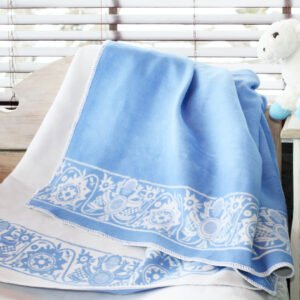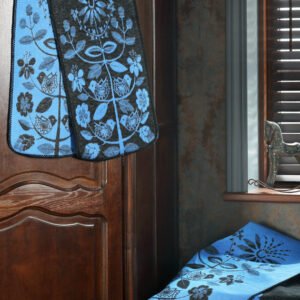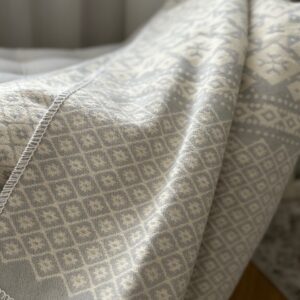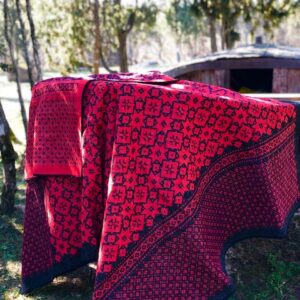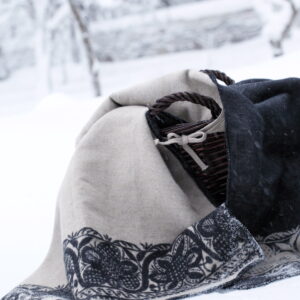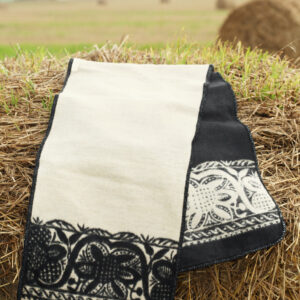+ Näita rohkem
-
Dimensions 140 x 200 cm 100% cotton In North Estonia, flower pattern was dominant in the first half of the 19th century.It seems strange how colourful, manifold and rich is the art of embroidery in the small territory of Estonia. A good example is the Jõelähtme sleeve pattern used on North Estonian scarf - its pattern is peculiar and diverse.Wrap was being worn lengthways on one’s back; the corners were secured on the breast with a brooch or yarn. The tradition of wearing wraps remained until the beginning of the 19th century.
-
Dimensions 66 x 180 cm 70% cotton, 30% flax In South Estonia, festive woollen rectangle wrap, worn across one’s shoulders, was the most respectable garment. In Põltsamaa, even on the 19th century oblong woollen shawls were worn. White shawl was decorated by using archaic techniques and patterns that had a deep meaning. South Estonian scarf is inspired by the shoulder piece of the Põltsamaa shirt where the pattern has been built up to form an ornament of diagonal cross and a quadrangle. That, in fact, is one of the oldest principles of composition. One of the characteristics of South Estonian handicraft is geometrical embroidery common in the late 18th century. White linen yarn was often used for that. Wrap had a specific role in the Jõgeva County wedding customs. When the bride was brought into the home of the bridegroom, her mother-in-law tied the wrap around the bride's head, covering the eyes as well.
-
Dimensions 70 x 200 cm 100% cotton
-
-
Size 35x200 What makes the Western Estonian shawl, traditionally called scarf, beautiful is its family tree motif that according to ancient traditions signifies happiness and the fulfilment wishes for a family. These are stories and patterns through which Ellu shawls celebrate a joyous occasion for our common home – the 100th independence day of the Republic of Estonia. The Western Estonian scarf draws its power and beauty from the family tree motif, widely cherished in Lääne County, the Western part of Estonia. This is the most widely used decoration for wedding blankets, however, its style varied from region to region. In the Lääne County, weavers used a special local technique and the tree was true to life and easily recognisable. On the island of Muhu , the wedding blankets woven at the end of the 19th century and the beginning of the 20th century were decorated using cross-stitching instead and the embroidery was very rich and expressive, fairy tale-like. The betrothed in Muhu embroidered motifs resembling trees into their blankets, decorated with multicolour leaves, songbirds, lush blooms and fruits. The hope was that these images would bring the family happiness and that all their wishes would come true. The artisans of that time especially favoured patterns featuring plants of various sorts, however, they also appreciated geometric lines. The tree motif can certainly be considered as the predecessor of the flower motif. To make sure even further that dreams would come true, the weavers decorated the top of the family tree with an octagram, a feature characteristic to Estonian folk patterns. Throughout history, the tree has been a widely used ornamental feature around the world. In handicraft arts, it has had powerful names such as the world tree, the tree of life and the tree of wishes. Estonians are a settled people that love their homeland, so this image has an additional significance – it reminds us of the ancient trees in the gardens of our farms and tells the tale of a heritage passed from generation to generation. Let this scarf and its family tree motif be a beautiful gift to all of us and remind us of what significant times we live in, and how important it is to protect our country and give each other gifts that bring good luck. The tradition of wearing shawls to cover shoulders goes back a long way. This shawl called scarf used to be considered the most valuable part of a traditional set of clothes, and it was mostly worn on special occasions. In cold weather, the scarf was worn to church or to go visit someone, but in warmer periods the scarf was worn looser, on the arms, to give a woman’s appearance that special celebratory note. Compared to other items of clothing, making a scarf required much more skill. Therefore, these shawls were cared for especially well and passed down from generation to generation, as were the skills used to make them.
-
West Estonian scarf Kihnu shawl 70x200 The creation of Kihnu shawl was greatly influenced by the creative heritage of an honourable Estonian textile designer, Anu Raud. Kihnu glove patterns that she loved and collected, and are now woven into the Kihnu shawl, bring luck and health to the people wearing them. Kihnu is a beautiful Estonian island where people wear folk costumes - körts (skirts), shawls, trois (knitted pullovers) and kapõtas (men’s socks) – nearly daily even nowadays. The islanders honour their native customs and beliefs, and thanks to their faithfulness in holding on to them, Anu Raud has managed to preserve the colourful and richly detailed patterns and textiles. The creative heritage of this folk art collector now adorns Kihnu shawl of Ellu sallid, as well as the treasury of Heimtali Museum of Local History. The shawl’s red colour was influenced by the ancient times when Kihnu folk costumes were dyed red, using roots of bedstraw. The colour red was believed to have healing and disease-repellent effect. Irrespective of the skirt’s colour nowadays, it is still trimmed with a red ribbon, in the hope of luck, health and protection according the folk belief. The pattern of Kihnu shawl has influence from bygone times as well. The shawl is adorned with troi pattern and a mixture of different styles, very much characteristic to the island’s gloves (traditionally, different patterns are used for different parts of Kihnu gloves and mittens). Kihnu gloves have always been made from indigo blue or white and black sheep wool. All these ancient ideas have been woven into the Ellu scarf. Kihnu shawl also brings octagram and knotted square motif into this day. The islanders believe the latter to be a “witch sign”. By using the sign together with other symbols, the wearer is believed to receive strength and power. The tradition of wearing scarves and shawls has a long history in Estonia. Shawls were considered to be the most valued piece of a folk costume and it was mainly a part of festive clothing. When it was cold outside, shawl would keep you warm while going to church or visiting someone. In warmer weather, it would add festivity to your outfit, being carried on your arm. More skilfulness was needed for making a shawl than for any other piece of clothing. Therefore shawls, as well as the knowledge and skills of making them, were well-kept and passed on to next generations. Kihnu shawl is reverence to the past, as well as to the present. My acknowledgements belong to the Estonian women, men and children who, throughout the history and in one way or the other, have honoured the story of our nation and keep doing so. To quote Anu Raud, “May our handicraft be the everyday seasoning and warmth in our homes!”
-
70x200 The creation of Kihnu shawl was greatly influenced by the creative heritage of an honourable Estonian textile designer, Anu Raud. Kihnu glove patterns that she loved and collected, and are now woven into the Kihnu shawl, bring luck and health to the people wearing them. Kihnu is a beautiful Estonian island where people wear folk costumes - körts (skirts), shawls, trois (knitted pullovers) and kapõtas (men’s socks) – nearly daily even nowadays. The islanders honour their native customs and beliefs, and thanks to their faithfulness in holding on to them, Anu Raud has managed to preserve the colourful and richly detailed patterns and textiles. The creative heritage of this folk art collector now adorns Kihnu shawl of Ellu sallid, as well as the treasury of Heimtali Museum of Local History. The shawl’s red colour was influenced by the ancient times when Kihnu folk costumes were dyed red, using roots of bedstraw. The colour red was believed to have healing and disease-repellent effect. Irrespective of the skirt’s colour nowadays, it is still trimmed with a red ribbon, in the hope of luck, health and protection according the folk belief. The pattern of Kihnu shawl has influence from bygone times as well. The shawl is adorned with troi pattern and a mixture of different styles, very much characteristic to the island’s gloves (traditionally, different patterns are used for different parts of Kihnu gloves and mittens). Kihnu gloves have always been made from indigo blue or white and black sheep wool. All these ancient ideas have been woven into the Ellu scarf. Kihnu shawl also brings octagram and knotted square motif into this day. The islanders believe the latter to be a “witch sign”. By using the sign together with other symbols, the wearer is believed to receive strength and power. The tradition of wearing scarves and shawls has a long history in Estonia. Shawls were considered to be the most valued piece of a folk costume and it was mainly a part of festive clothing. When it was cold outside, shawl would keep you warm while going to church or visiting someone. In warmer weather, it would add festivity to your outfit, being carried on your arm. More skilfulness was needed for making a shawl than for any other piece of clothing. Therefore shawls, as well as the knowledge and skills of making them, were well-kept and passed on to next generations. Kihnu shawl is reverence to the past, as well as to the present. My acknowledgements belong to the Estonian women, men and children who, throughout the history and in one way or the other, have honoured the story of our nation and keep doing so. To quote Anu Raud, “May our handicraft be the everyday seasoning and warmth in our homes!”
-
140x200 The creation of Kihnu shawl was greatly influenced by the creative heritage of an honourable Estonian textile designer, Anu Raud. Kihnu glove patterns that she loved and collected, and are now woven into the Kihnu shawl, bring luck and health to the people wearing them. Kihnu is a beautiful Estonian island where people wear folk costumes - körts (skirts), shawls, trois (knitted pullovers) and kapõtas (men’s socks) – nearly daily even nowadays. The islanders honour their native customs and beliefs, and thanks to their faithfulness in holding on to them, Anu Raud has managed to preserve the colourful and richly detailed patterns and textiles. The creative heritage of this folk art collector now adorns Kihnu shawl of Ellu sallid, as well as the treasury of Heimtali Museum of Local History. The shawl’s red colour was influenced by the ancient times when Kihnu folk costumes were dyed red, using roots of bedstraw. The colour red was believed to have healing and disease-repellent effect. Irrespective of the skirt’s colour nowadays, it is still trimmed with a red ribbon, in the hope of luck, health and protection according the folk belief. The pattern of Kihnu shawl has influence from bygone times as well. The shawl is adorned with troi pattern and a mixture of different styles, very much characteristic to the island’s gloves (traditionally, different patterns are used for different parts of Kihnu gloves and mittens). Kihnu gloves have always been made from indigo blue or white and black sheep wool. All these ancient ideas have been woven into the Ellu scarf. Kihnu shawl also brings octagram and knotted square motif into this day. The islanders believe the latter to be a “witch sign”. By using the sign together with other symbols, the wearer is believed to receive strength and power. The tradition of wearing scarves and shawls has a long history in Estonia. Shawls were considered to be the most valued piece of a folk costume and it was mainly a part of festive clothing. When it was cold outside, shawl would keep you warm while going to church or visiting someone. In warmer weather, it would add festivity to your outfit, being carried on your arm. More skilfulness was needed for making a shawl than for any other piece of clothing. Therefore shawls, as well as the knowledge and skills of making them, were well-kept and passed on to next generations. Kihnu shawl is reverence to the past, as well as to the present. My acknowledgements belong to the Estonian women, men and children who, throughout the history and in one way or the other, have honoured the story of our nation and keep doing so. To quote Anu Raud, “May our handicraft be the everyday seasoning and warmth in our homes!”
-
The creation of Kihnu shawl was greatly influenced by the creative heritage of an honourable Estonian textile designer, Anu Raud. Kihnu glove patterns that she loved and collected, and are now woven into the Kihnu shawl, bring luck and health to the people wearing them. Kihnu is a beautiful Estonian island where people wear folk costumes - körts (skirts), shawls, trois (knitted pullovers) and kapõtas (men’s socks) – nearly daily even nowadays. The islanders honour their native customs and beliefs, and thanks to their faithfulness in holding on to them, Anu Raud has managed to preserve the colourful and richly detailed patterns and textiles. The creative heritage of this folk art collector now adorns Kihnu shawl of Ellu sallid, as well as the treasury of Heimtali Museum of Local History. The shawl’s red colour was influenced by the ancient times when Kihnu folk costumes were dyed red, using roots of bedstraw. The colour red was believed to have healing and disease-repellent effect. Irrespective of the skirt’s colour nowadays, it is still trimmed with a red ribbon, in the hope of luck, health and protection according the folk belief. The pattern of Kihnu shawl has influence from bygone times as well. The shawl is adorned with troi pattern and a mixture of different styles, very much characteristic to the island’s gloves (traditionally, different patterns are used for different parts of Kihnu gloves and mittens). Kihnu gloves have always been made from indigo blue or white and black sheep wool. All these ancient ideas have been woven into the Ellu scarf. Kihnu shawl also brings octagram and knotted square motif into this day. The islanders believe the latter to be a “witch sign”. By using the sign together with other symbols, the wearer is believed to receive strength and power. The tradition of wearing scarves and shawls has a long history in Estonia. Shawls were considered to be the most valued piece of a folk costume and it was mainly a part of festive clothing. When it was cold outside, shawl would keep you warm while going to church or visiting someone. In warmer weather, it would add festivity to your outfit, being carried on your arm. More skilfulness was needed for making a shawl than for any other piece of clothing. Therefore shawls, as well as the knowledge and skills of making them, were well-kept and passed on to next generations. Kihnu shawl is reverence to the past, as well as to the present. My acknowledgements belong to the Estonian women, men and children who, throughout the history and in one way or the other, have honoured the story of our nation and keep doing so. To quote Anu Raud, “May our handicraft be the everyday seasoning and warmth in our homes!”
-
Dimensions 75 x 180 cm 70% cotton, 30% flax In Pärnu County, wrap from fine wool and as big as blankets were thrown across one’s arm when going to church. This is where the name comes from – On-Arm Plaid. At large, the wrap was being worn across one’s shoulders. The characteristic of Estonian folk costumes is expressed in beautiful embroidery. Pärnumaa scarf has coif embroidery with original ornament where black woollen yarn is used.
-
Ellu sallide kinkepakend kannab endaga salli lugu.Pakend annab hea võiamluse sall kingitusena kinkida. Pakend on tehtud spetsiaalselt nii, et see oleks loodust ja ühiskonda säästev. Pakendi on mõõtudes 330x300x80mm. Ja selle hind on 5€. Anna meile oma soovist teada, kui teed läbi e-poe tellimuse või soovid juba soetatud sallile pakendit.
-
Dimensions 35 x 180 cm 70% cotton, 30% flax In Pärnu County, wrap from fine wool and as big as blankets were thrown across one’s arm when going to church. This is where the name comes from – On-Arm Plaid. At large, the wrap was being worn across one’s shoulders. The characteristic of Estonian folk costumes is expressed in beautiful embroidery. Pärnumaa scarf has coif embroidery with original ornament where black woollen yarn is used.


